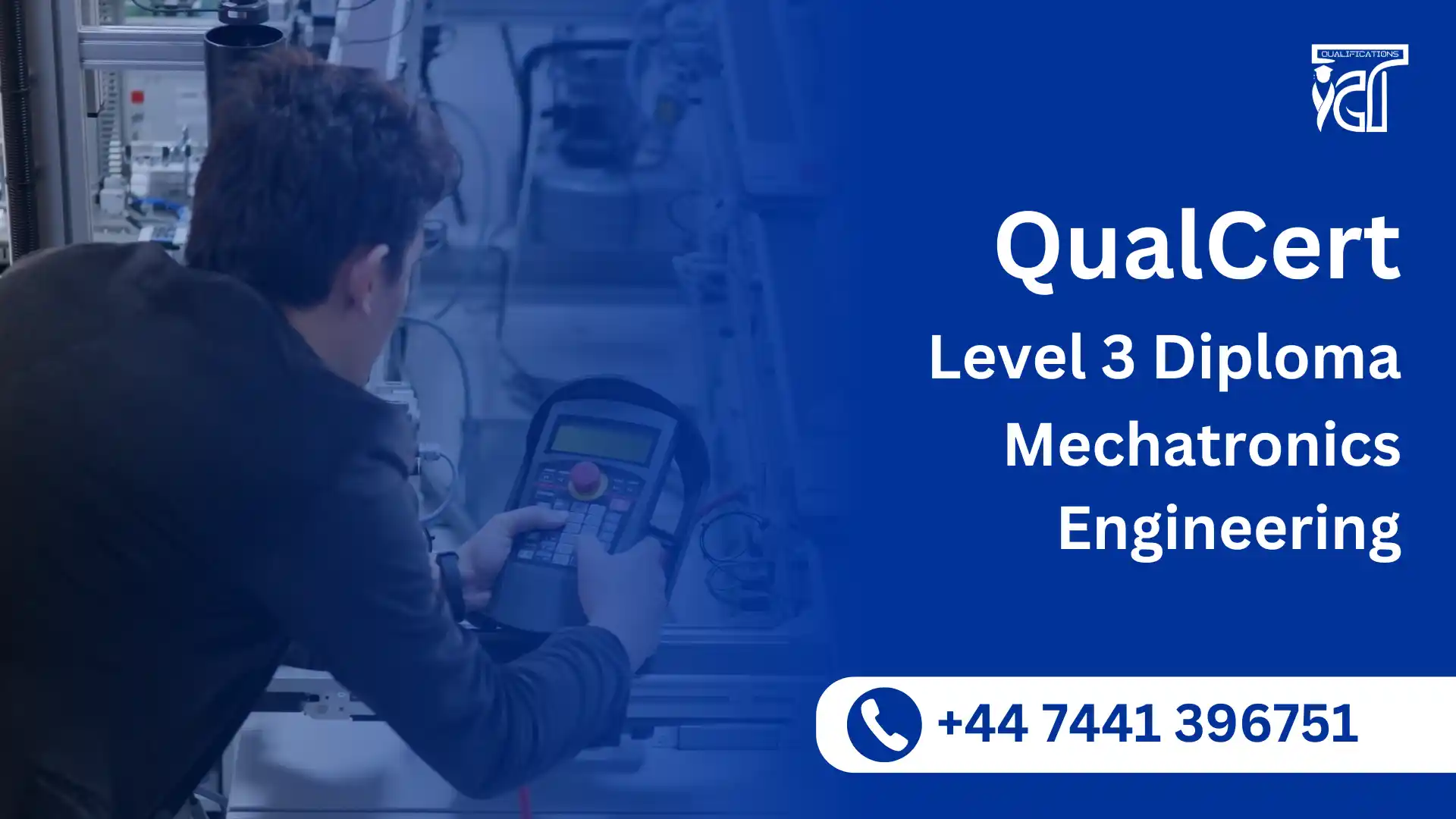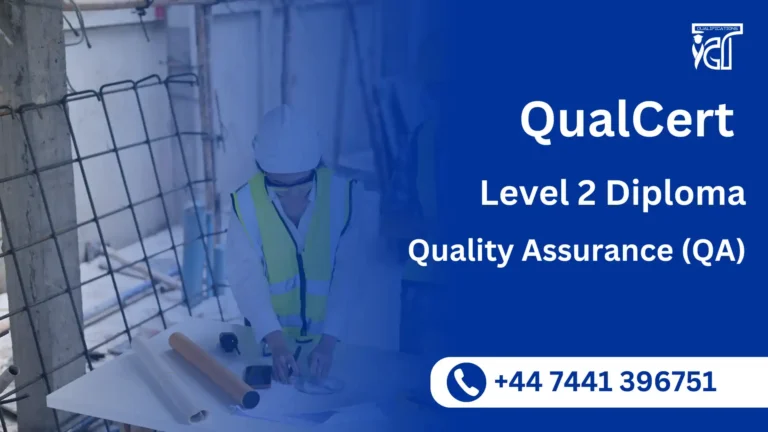The QualCert Level 3 Diploma in Mechatronics Engineering is a comprehensive vocational qualification designed to equip learners with the technical knowledge and practical skills essential for careers in the dynamic field of mechatronics. This multidisciplinary course integrates principles from mechanical engineering, electronics, electrical engineering, and computer control systems to prepare learners for roles in modern industrial automation and intelligent manufacturing systems.
Through a combination of theoretical instruction and hands-on practical training, learners will develop competencies in areas such as electrical and electronic circuit design, programmable logic controllers (PLCs), robotics, mechanical system maintenance, and process control. Emphasis is placed on problem-solving, system integration, troubleshooting, and the safe operation of mechatronic equipment commonly used in industries such as automotive, aerospace, manufacturing, and robotics.
The QualCert Level 3 Diploma in Mechatronics Engineering is suitable for individuals seeking to enter the mechatronics industry, as well as those already employed who wish to enhance their technical proficiency and career prospects in a rapidly advancing technological sector. Upon successful completion, learners will possess the foundational skills and knowledge required to progress into higher education or secure employment in a range of engineering and automation roles.
QualCert Level 3 Diploma in Mechatronics Engineering
The QualCert Level 3 Diploma in Mechanical Technology is a 60 credits qualification with a Total Qualification Time (TQT) of 300 hours, including 210 Guided Learning Hours (GLH). This course is thoughtfully designed to provide targeted and efficient skill development in the field of Mechanical, offering learners a solid foundation to build their expertise.
| Unit Ref# | Unit Title | Credit | GLH | TQT |
| QC03005 – 1 | Mechatronics System Design | 10 | 35 | 50 |
| QC03005 – 2 | Embedded Systems & Microcontrollers | 10 | 35 | 50 |
| QC03005 – 3 | Sensors & Actuators | 10 | 35 | 50 |
| QC03005 – 4 | Industrial Robotics & Control | 10 | 35 | 50 |
| QC03005 – 5 | Mechatronics Integration & Simulation | 10 | 35 | 50 |
| QC03005 – 6 | Control Systems Engineering | 10 | 35 | 50 |
GLH (Guided Learning Hours) and TQT (Total Qualification Time) are terms commonly used in vocational qualifications to help define the amount of time a learner is expected to spend on their studies.
1. GLH (Guided Learning Hours)
GLH refers to the number of hours a learner spends being directly taught, supervised, or supported during their course. This includes the time spent in activities such as:
- Classroom instruction
- Practical workshops
- One-on-one tutoring or mentoring sessions
- Online learning sessions with tutor support
In other words, GLH represents the time that learners are actively engaged with their instructors or learning activities.
2. TQT (Total Qualification Time)
TQT represents the total amount of time a learner is expected to invest in completing a qualification, including:
- GLH (Guided Learning Hours): Time spent on direct learning, as explained above.
- Self-Directed Learning: This includes time spent on independent study, research, assignment completion, preparation for exams, and any other work the learner does outside of direct teaching hours.
TQT is a broader measure that includes all the time required to achieve the qualification. It helps learners and employers understand the overall commitment required for the qualification.
Key Differences Between GLH and TQT:
- GLH focuses on direct learning with guidance or supervision.
- TQT includes GLH as well as independent study time and other learning-related activities.
Example:
If a qualification has a TQT of 600 hours and a GLH of 250 hours, it means the learner should spend 250 hours in direct learning (classroom, online, or tutor-led sessions) and 350 hours on independent study or research.
Upon successful completion of the Level 3 Diploma in Mechatronics Engineering, learners will be able to:
- Mechatronics System Design
- Gain a thorough understanding of the principles and methodologies involved in designing mechatronic systems.
- Develop the ability to analyze and evaluate the requirements for integrating mechanical, electrical, and software components.
- Learn how to design and simulate mechatronic systems to meet specified performance, efficiency, and safety standards.
- Acquire skills in selecting appropriate materials, components, and technologies for the system design process.
- Understand the trade-offs in design decisions and their impact on system performance and cost-effectiveness.
- Embedded Systems & Microcontrollers
- Understand the role and architecture of embedded systems in mechatronics applications.
- Gain proficiency in programming microcontrollers for real-time control and system integration.
- Develop skills in designing, testing, and troubleshooting embedded systems for mechatronic applications.
- Learn how to interface microcontrollers with sensors, actuators, and other electronic components in a mechatronic system.
- Acquire knowledge in using embedded systems to control and automate complex mechanical and electrical processes.
- Sensors & Actuators
- Understand the working principles of various sensors and actuators used in mechatronics applications.
- Develop the ability to select and integrate sensors for measurement and feedback within mechatronic systems.
- Learn to choose appropriate actuators to control mechanical movements and responses.
- Gain skills in calibrating and troubleshooting sensors and actuators to ensure accurate performance.
- Understand the role of sensors and actuators in providing real-time data for control systems in mechatronic applications.
- Industrial Robotics & Control
- Understand the fundamentals of industrial robots, including kinematics, dynamics, and control systems.
- Develop the ability to program and operate industrial robots for automation tasks in manufacturing environments.
- Learn the integration of sensors, actuators, and control systems in robotic systems for precise and efficient operations.
- Acquire hands-on experience with robotic systems, including simulation and troubleshooting techniques.
- Understand safety protocols, operational limits, and performance optimization in industrial robotics applications.
- Mechatronics Integration & Simulation
- Learn how to integrate mechanical, electrical, and software components into a cohesive mechatronic system.
- Develop skills in simulating mechatronic systems to predict performance and identify potential issues before physical implementation.
- Understand system-level design and optimization techniques to improve overall system functionality and efficiency.
- Gain proficiency in using simulation software and tools for modeling and testing mechatronic systems.
- Develop the ability to apply integration and simulation techniques in real-world industrial scenarios.
- Control Systems Engineering
- Understand the fundamental principles of control systems used in mechatronics, including feedback loops, stability, and system dynamics.
- Develop the ability to design and implement control systems for managing mechatronic systems and ensuring desired performance.
- Learn about various control strategies, such as PID (Proportional-Integral-Derivative) control, and their application in mechatronics.
- Gain proficiency in using software tools to model, simulate, and tune control systems.
- Understand the practical aspects of control system implementation, including real-time monitoring, performance evaluation, and system optimization.
Course Benefits: QualCert Level 3 Diploma in Mechatronics Engineering
Multidisciplinary Skill Development
Gain in-depth knowledge across multiple engineering fields—including mechanical, electrical, electronic, and computer control systems—essential for modern industrial environments.
Hands-On Practical Training
Benefit from practical, workshop-based learning that enhances your ability to work confidently with real-world mechatronic systems, machinery, and automation equipment.
Industry-Relevant Knowledge
Learn the latest industry practices and technologies used in manufacturing, robotics, process control, and smart systems, aligning your skills with employer expectations.
Enhanced Problem-Solving Abilities
Develop critical thinking and troubleshooting skills essential for diagnosing faults, maintaining systems, and ensuring the smooth operation of automated processes.
Improved Employability
This qualification opens doors to various roles in sectors such as automotive manufacturing, aerospace, robotics, industrial automation, and smart technologies.
Foundation for Higher Studies
Acts as a stepping stone for further qualifications in engineering, such as Level 4 Diplomas, Higher National Diplomas (HND), or degree-level studies in Mechatronics or related fields.
Meets Industry Safety Standards
Learn best practices for safe working procedures, risk assessment, and compliance with industry regulations to ensure safety in complex engineering environments.
Versatile Career Options
Prepares you for a variety of technical roles, including Mechatronics Technician, Automation Engineer, Maintenance Engineer, and Control Systems Technician.
Enhancement of Analytical and Technical Skills
Refine your ability to interpret technical documentation, electrical schematics, and mechanical blueprints used in designing and maintaining integrated systems.
Adaptability to Technological Changes
Equips learners with the flexibility to adapt to emerging technologies in Industry 4.0, smart factories, and the Internet of Things (IoT).
Ideal Learner: QualCert Level 3 Diploma in Mechatronics Engineering
The QualCert Level 3 Diploma in Mechatronics Engineering is ideal for individuals who are:
Aspiring Engineers and Technicians
Young learners or school leavers who have a strong interest in engineering, robotics, or automation and wish to begin a career in a high-tech, multidisciplinary field.
Technical and Vocational Students
Learners with a background in science, technology, engineering, or mathematics (STEM), looking to specialize in a hands-on, industry-focused qualification.
Engineering Apprentices
Individuals currently in engineering apprenticeships who want to formalize and enhance their practical and theoretical understanding of mechatronic systems.
Early-Career Professionals in Manufacturing or Automation
Entry-level workers in factories, production plants, or technical support roles who seek to advance their qualifications and improve career prospects in maintenance, systems operation, or automation.
Career Changers with a Technical Interest
Adults from other professions who possess a mechanical or electrical aptitude and want to transition into a career in engineering or industrial automation.
Innovators and Tinkerers
Hands-on learners who enjoy building, designing, or troubleshooting mechanical and electrical systems, and who thrive in practical, problem-solving environments.
Learners Planning Higher Education in Engineering
Those who aim to pursue advanced qualifications in engineering or related fields and want a strong, skills-based foundation at the Level 3 stage.
Entry Requirements
Register Now
Qualification Process
Qualification Process for the QualCert Level 3 Diploma in Mechatronics Engineering
- Self-Assessment:
Begin by evaluating your eligibility to ensure you meet the qualification requirements, including work experience, knowledge, and language proficiency. - Registration:
Complete your registration by submitting the required documents, including a scanned copy of a valid ID, and paying the registration fee. - Induction:
An assessor will conduct an induction to confirm your eligibility for the course and explain the evidence requirements. If you do not meet the criteria, your registration will be canceled, and the fee will be refunded. - Assignmnets & Evidence Submission:
Provide all assignmnets and the necessary evidence based on the assessment criteria outlined in the course. If you are unsure of the required evidence, consult with the assessor for guidance on the type and nature of evidence needed. - Feedback and Revision:
The assessor will review your submitted evidence and provide feedback. Evidence that meets the criteria will be marked as “Criteria Met,” while any gaps will be identified. You will be asked to revise and resubmit if needed. - Competence Evidence:
Submit final evidence demonstrating that all learning outcomes have been met. This evidence will be marked as “Criteria Met” by the assessor once it is satisfactory. - Internal Quality Assurance (IQA):
The Internal Quality Assurance Verifier (IQA) will review your evidence to ensure consistency, quality, and compliance with standards. - External Verification:
The IQA will submit your portfolio to QualCert External Quality Assurance Verifiers (EQA) for final confirmation. The EQA may contact you directly to verify the authenticity of your evidence. - Certification:
Upon successful completion of all checks, QualCert will issue your official certificate, confirming that you have attained the QualCert Level 3 Diploma in Mechatronics Engineering.







